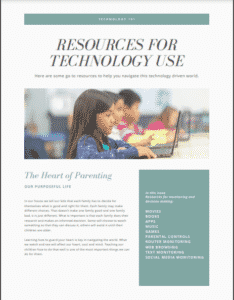“If a car comes up to you and a stranger offers you a piece of candy, don’t take it. Turn and run away screaming.”
This was the “Stranger Danger” talk you may remember if you were a child of the 80’s and 90’s. But things are a lot more complicated today. Drive-by abductions have been replaced with online predators. Now we need to have conversations with our kids about random adults at parks, public restrooms, text messages and social media. It can seem overwhelming to think about all that we have to cover. If we even know what to cover. But first things first: Like all other parenting topics, this one starts with relationship and conversation!
The Ultimate Safeguard: Relationship With You
The most important thing you can do to help protect your children from danger is to have a home where you encourage openness, honesty and questions. Your children need to know that you are a safe place to talk about anything and everything. This type of environment is easiest to create if you start when they are little. Check out the blog post for how to begin this lifestyle with your littles. You will be so glad that you did!
But if your kids aren’t little, it is never too late to create a safe environment for conversations to happen. If your children don’t come to you to talk, think about why. Is it because you haven’t made space for it in your natural rhythm of life? Maybe it is because you didn’t feel equipped to talk to you children about important issues. Or maybe when your kids did come, you didn’t make time or you responded in an annoyed or judgmental way. No matter the reason, you can always begin again.
Come to your child or teen with a humble and repentant heart. Tell them you are sorry for how the conversations have gone in the past and tell them you are committed to making your house a safe and loving environment where anyone can ask anything and talk about anything. Admit you don’t know all the answers but with God you can figure out what is the best plan for your family.
This is our most important point: If you build this safe, open relationship with your kids they will feel safe to tell you if something bad happens. And hopefully, they will tell you enough about their life that you can help them avoid bad things before they start! This will prevent them from going into silence and shame.
Conversations About Physical Safety
A few weeks ago we talked about teaching our kids how to interact with those they do not know. Today we are going to talk about how to teach your children who is safe and who is not. Unfortunately one of the main reasons we now need to talk to our children about stranger danger is because of sexual abuse. It has always been around, but it has become an even greater risk in our current society.
We came across two excellent books that you can read and discuss with your children. A while back Nathan took the boys and I took the girls. We each took one book, went through it with our kids, and then we switched the books. The girls were well beyond the target age for the books, but it still allowed us to have a really good conversation. I just told them to ignore the childish graphics. 🙂
Here are the two books:
- Good Pictures Bad Pictures by Kristen A. Jenson. There is also a Junior version for 3-7 years old.
- I Said NO! By Kimberly King
Side Note: The boys did NOT enjoy this conversation, and it was very awkward. But it was still the right thing to do! Sometimes in parenting you have to push through the awkward as part of your job!
Online Safety
It is important that you have safety rules when it comes to phones. There are a lot of bad people out there who have learned to be crafty in their texting and social media use. It is vital that we train our children to know what is safe and what is not. Here is an article to get you started. Protecting Your Teen From Online Predators.
We love these resources, and they are our go-to when we have questions:
- Protect Young Minds: Very practical and helpful resources.
- START Ministry: “Helping families pursue digital health, so that kids grow up captivated by life, not screens.”
- Axis: Seriously – this resource is so helpful for parents of tweens and teens! Teen culture is so foreign to us, and they help to make the connection.
- Dr. Meg Meeker: We love Dr. Meeker’s books and resources!
Check out the resource we put together to help you Guard Their Hearts!
Basic Safeguards (aka Rules)
It is also important to start thinking about what rules you will have for your children to decrease the chances of bad things happening. Here are some of the safety rules we have in place at our home. (Note: We tell our kids all the time that different families have different rules. We aren’t saying that these are the rules you have to have, but we share them as examples of the way that we are choosing to address the subject.)
- Friends of the opposite gender are not allowed in bedrooms.
- When both guys and girls are playing or hanging out together it is done in open places of our home or outside.
- Going into a neighbor’s home is not allowed unless a relationship has been built with the parents and family rules are known and accepted by the family.
- When children are little and through elementary age, we accompany them at playdates and birthday parties. Especially if we don’t really know the family.
- Video games and movies are not allowed to be played at friends’ houses unless preapproved.
- Playdates are allowed at a friend’s house only if the mom is home the whole time.
- For our girls, they are not allowed to ride in a car with another family’s dad or brother unless there is a 3rd person in the car.
- Sleepovers are not allowed. We do allow them to hang out until late and depending on what they are doing the next morning we will take them back to finish out the party. When the girls were in high school, we allowed them on very special occasions, like after dances, to stay with families we knew well.
- Texting is limited to preapproved friends and family. They are first allowed to text from a parent’s phone until trust with them and their friends are earned. Then they transition to their own phone when they have a phone of their own. Once on their own phone, they are only allowed to text the same gender and not allowed to be on class group texts. As they age, they are allowed to text more people and both genders.
- Taking pictures on their phone is allowed, but we talk about the importance of being careful about what pictures are taken of them on their phone and on other’s phones. We can not control what others do with those pictures so it is important that they are mindful of what is going on around them. We also talked about the importance of changing clothes in a safe and private area so that no cameras are out during that time.
- The kids are not allowed on social media. Their junior and senior year we allow them to get a few very limited accounts to practice with under our guidance.
- Phones, computers, iPads are used in open, public spaces in the home and are reviewed and monitored.
- Electronics are docked and charged in the kitchen at night and not in individual bedrooms.
- Safe people. As the kids get older and are not always with us we talk about safe people they can talk to if at any point they feel unsafe or if something bad is happening to them, their friends or siblings.
- We have different code words that they can text or ways they can communicate on the phone that alert us to come and get them immediately.
While at times I am sure it is frustrating that we have these rules, there have been several times the girls appreciated our stance because it made them feel safe and protected. A couple of times it has also helped them in an awkward situation where they were able to make Nathan and I the “bad guys” and not hurt their friendships. Sometimes it is a relief to say, “I’m sorry, I can’t. My parents won’t let me.”
Prepared For Life
As our kids are transitioning to high school, these rules have been adjusted. As they get older, the rules become more of a conversation than simply us telling them what to do. The kids are able to voice their opinion, and then we work together to come up with a plan that works for all. We are also talking a lot more about the “Why” behind all of the rules. Phone rules , sleepovers and social media are all rules that will be adjusted as trust is earned and as they age. As we step them towards full control they will learn how to monitor and keep themselves safe in the future. Because pretty soon they will be out on their own and they will have to decide what rules they want to follow.
It is important that our children know how to safely navigate texting, social media and social gatherings before they leave our home. This is where it is important that you follow the Holy Spirit’s guidance and start to relax the rules as the child matures and is ready to take on more responsibility. Remember our job as parents is to prepare them for adulthood. By the time they leave your home, they should be prepared to set their own boundaries.
Our first job as parents is to protect our kids from the physical, emotional, and spiritual dangers that surround them. We can face this task without fear if we trust God and take purposeful action. If we start with relationship and conversations, we can create rules that keep our kids safe while still keeping their hearts open to us.
You May Also Like…









Your rules sound exactly like the ones we had for our children when they were growing up! They didn’t always love them, but they were good about following them.